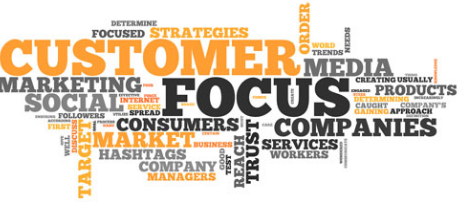How does your company value and weigh market orientation in relation to your clients? Companies need to evolve and diversify their approach — removing focus from selling points and functionality. You must achieve a customer focused company.

Putting the client first with market orientation means co-creating with the customer and adapting in regard to experience, engagement, and social impact.
When you focus on market orientation, does your company’s analysis strictly focus on quantitative measurements? What about the qualitative? Here are ten traits to consider when looking to optimize the impact you have on the client experience and become a more client-focused company.
Managers like to tell employees, “the customer is always right”– thinking that this phrase alone will make them a customer-focused company.
However, making the customer the centerpiece of your business is a lot easier said than done. Being customer-focused requires a complete alignment with your customer’s success.
But if it’s all this work, then what’s the payoff? Building a customer-focused company can differentiate yourself from competitors, and help sustainably grow your business.
Customer Focus
Companies that are customer-focused have a culture dedicated to meeting all of their customers’ needs. They ensure all facets of the business prioritize customer satisfaction as the primary concern.
Customer-focused companies develop close relationships with their customer base and are deeply invested in customer success.
In May 2007, Ranjay Gulati (Michael Ludwig Nemmers Distinguished Professor of Strategy and Organizations at Northwestern University‟s Kellogg School of Management), wrote an article for the Harvard Business Review entitled “Silo Busting: How to Execute on the Promise of Customer Focus”.
Gulati‟s point is as true today as it was then — that while many companies claim to be focused on their customers, they are unable to deliver on these promises within their current company culture. His basis for this argument is that companies continue to focus on their own needs versus customer needs.
Gulati identified four values that companies must adopt in order to successfully be customer-focused. These are coordination, cooperation, capability, and connection.
Coordination: Most companies are organized around a specific function, product, or geographical location. However, customers don‟t think that way, and often the solutions they need do not fit within those boundaries. Gulati suggests that companies need to create processes or mechanisms that break these divisions – or silos – so that the customer gets the benefit of the entire company.
Cooperation: Here the focus is two-fold. Separate business units need to cooperate to support each other‟s activities to achieve measurable customer satisfaction, and employees who are closest to customers need the authority to make decisions that benefit the customer. This kind of cooperation ensures the customer always comes first.
Capability: According to Gulati, companies need more “generalists”. These are described as employees who “have experience in several products or services and deep knowledge of customer needs” as well as having the skill and flexibility to cross organizational boundaries. These people see the big picture and the resultant are able to produce tailored solutions that meet customer needs.
Connection: Gulati‟s research supports aligning with suppliers and partners. The rationale is that it supports better solutions for the customer as well as provides cost-cutting opportunities.
Gulati‟s four “C‟s” make sense, as they provide companies with a process map that focuses on the customer. Interesting to note, everything still focuses on the big „C‟ — the customer.
There are a few common imperatives shared by all successful customer-focused companies. Scholars may debate the exact number or wording, but it is universally agreed that to create a well-integrated organization, these basic characteristics must be in place.
If any of these essential ingredients are missing, no organization will achieve its full potential.
A customer-focused vision
Nothing is more important than a clear vision. In a customer-focused organization, the vision is not just making money but having the customer as a central element.
Every person should understand what that vision is — and how their role within the organization contributes directly to the implementation of that vision.
A well-defined and widely shared and understood vision will allow the organization to work in alignment with serving your customers well.
Inculcate the voice of the customer
Understand your customer intimately. Make sure your decision-making process includes their voice at the table. Evaluate all your processes and procedures to ensure they are designed with the customer in mind — not the organization.
You will revolutionize your own behavior and create linkages to your customers your competition will never duplicate
- .
Be a student of the best
Be a life-long learner. Study the methods of other successful companies, and share your learning in return. Japanese companies learned how to be great after World War II.

Some North American companies have made great comebacks after studying those from around the world — while others have chosen not to learn and suffered greatly as a result (American Auto Industry comes to mind.)
On a scale of one to ten, do believe you measure and map client experience accurately?
What did your customers have to say about that when you shared the data with them? How well does a scale of ten numbers measure the spectrum of experience beyond endpoint, yes-or-no satisfaction?
Focus more on client experience than the low bar of mere satisfaction. List fill-in-the-blank areas for qualitative feedback alongside quantitative scales on surveys and hold dialogues outside these forms.
Check and address reviews in real-time. Don’t let the company remain complacent with satisfaction. Exceed expectations and provide a meaningful and valuable experience for the client.
Engaged in the client’s thought process
How engaged are you with clients? Never assume your knowledge of a client’s thinking is accurate.
Analytics alone won’t get inside the client’s brains. What are their desires and deeper needs? An old-fashioned sit-down is necessary to cultivate a revealing dialogue that will influence brand loyalty and drive results.
Engaged leadership
Client focus doesn’t end with the employees on the front lines. Leaders should not exist within a higher-class bubble working from a top-down approach — employees and clients aren’t going to climb the leader to shake hands with their ego.

Engaged leadership is a vital component of a client-focused company. If employers care about both employees and customers, then employees will also thrive and give their best to customers.
Leaders must remain engaged in internal work culture at all levels and engaged with their customers externally.
Engaged workforce
Loyal employees serve loyal clients. The focus on engagement in work culture assists with boosting positive work morale.
Among American workers, 89 percent feel somewhat or mostly satisfied with their existing job, but two out of five did consider the possibility of looking for a new position within the next year.
Do your employees feel engaged? When employees feel engaged by their roles and leadership, they focus on providing outstanding experiences for customers rather than looking for another job where they feel valued, challenged, and well-treated by management.
Collaborative
Don’t segregate customer data and feedback, within reason of data sensitivity and privacy concerns. Open the doors for employees to weigh customer concerns and actively listen to provide better service. This opens a circular view of the client versus a linear view limited by singular experience.
Set up one-on-one meetings where clients may speak to a live person about their concerns or invite groups into a video meeting or conference call where they can provide feedback or feel involved in matters that directly impact them.
Responsive
In the digital age, being responsive to detail and solutions quickly is vital for a client-focused company. Companies must assimilate rapidly shifting consumer channels to stay relevant.
Companies must respond to customers and address their needs in real-time. Their products must also be more diversely responsive than in the past, adapting with flexibility to shifting needs and concerns. It’s also important to take time to research and address sensitive matters.
Creative
Companies who embrace creativity actively report more competitive leadership and higher market share by a 1.5 to one ratio overtaking others in their industry, but 61 percent of businesses don’t consider themselves creative. Leaders who capitalize on creativity put it on their business agendas.
Successful client-focused companies promote, nurture, and fund programs that cultivate creative capital and capabilities, such as through earlier technology adoption or brainstorming practices.
They encourage activities within and outside the workplace. They engage in dialogue with the customer to increase brand loyalty and co-creation.
Innovative
Milk customers for all you can get when it comes to innovation that arises out of co-creation with clients. The art of being a client-focused company lies inactive innovation which must be timed appropriately with a mix of creative capital derived from a company’s talent, the right technology, and direct penetration into client thought. Don’t be afraid to experiment.
Individual attention
Analytics focuses on pools or pockets of clients represented while the individual client may go without proper attention to detail. Word of mouth and personal recommendation is vital, so don’t let the little guy go forgotten as you strive to meet metrics goals.
Social conscientiousness
More companies tie their mission to social missions, helping communities locally and worldwide because the digital age has made the world smaller and clients see the effects. What is true service, especially if your product, time, and money can do a world of good for the world? Do the leaders, employees, and clients volunteer? How?
A client-focused company must rethink what market orientation and customer satisfaction mean to them. In the digital age, companies challenge themselves to innovate, collaborate, and give back.
Empower your customer champions
Most employees want to serve customers well. When the organization demonstrates that providing exceptional service in an organizational priority and that the employee is critical to success, then employees will rise to the challenge and amaze you with their commitment to exceeding customer expectations.
Break through the barriers to success
Too many organizations have processes and procedures in place that inadvertently create artificial barriers to successfully serving customers. Procedures and processes are designed with the organization in mind versus the customer and resultant, the customer is unclear or frustrated.
Are your sale processes clear to the customer, are your invoices easy to read and understand, and do your policies make sense from the customers’ perspective?
.